Ordinary Places
-
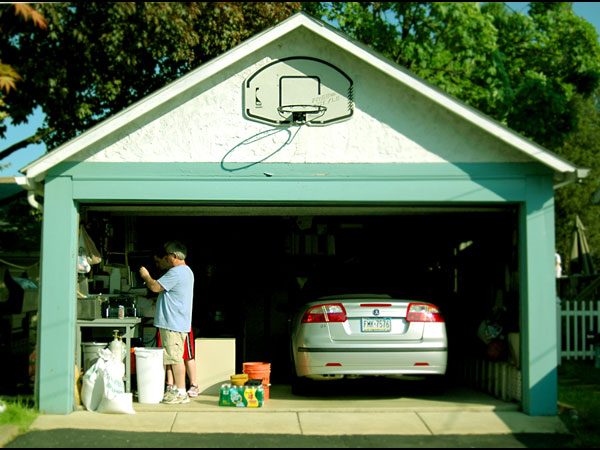 Photograph by CREDIT: Jody Ferry.
Photograph by CREDIT: Jody Ferry.The great landscape historian, J.B. Jackson, a chronicler of the everyday, once described what he called the domestication of the garage. He pointed out that in addition to—and sometimes instead of—housing cars, the all-purpose garage may also serve as a pantry, laundry, garden shed, workshop, hobby room, play area, and home office, not to mention catch-all storage space. People using a garage (with the door open) as a covered porch in the rain are a common site in the country. The wide concrete apron in front, so derided by critics of suburban housing, is not only a place to park; on weekends it's a car-wash, and during the week it turns into a basketball court. Indeed, the garage basketball hoop is as familiar a domestic symbol as the front-porch rocker. Jackson, who died 10 years ago, made us look afresh at the ordinary places that we take for granted, and if we look around today, we will find more examples of what he called the vernacular landscape.
-
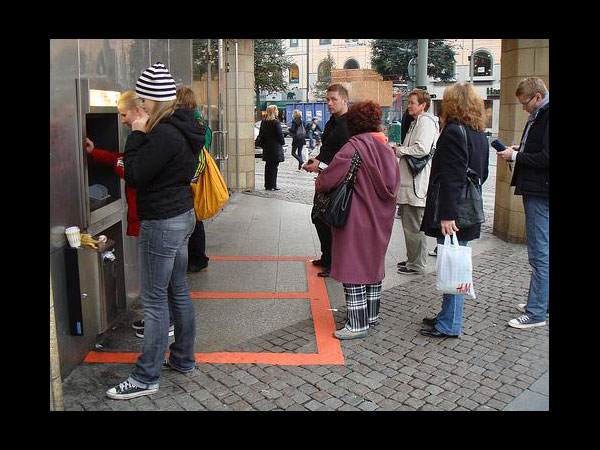 Photograph by CREDIT: Kelly Hirano © Kelly Hirano.
Photograph by CREDIT: Kelly Hirano © Kelly Hirano.In a few short decades, we have abandoned the teller's wicket in favor of the automatic teller machine. ATMs, introduced in the 1960s and initially confined to bank vestibules, have sprung up everywhere, in bus stations, airports, malls, convenience stores, in the street. ATMs are as common as phone booths once were, but whereas the first phone booths were like small private rooms—cozy confessionals—cash machines don't put on airs; they are designed without any pretence—soft-drink machines have more style. The ATM is a machine, yet the sidewalk around a cash machine becomes a real, albeit temporary, place. In Sweden (right) banking machines have a privacy zone, rare in America, where people dutifully keep their distance. The disciplined ATM line is a glum place, however, for there is nothing less convivial than a group of people waiting to deplete their savings accounts.
-
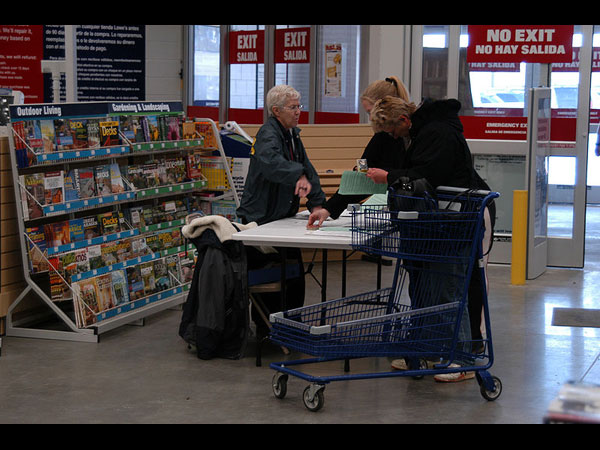 Home Depot in Fernley, Nev., via Wikipedia. This image is in the public domain.
Home Depot in Fernley, Nev., via Wikipedia. This image is in the public domain.At first glance, the big-box store doesn't foster sociability. The no-frills environment sends the message that "we are doing everything possible to keep our prices down," and the assembly-line atmosphere encourages speed and efficiency. Everyone is absorbed in the serious business of finding what they're looking for, a task the long, identical aisles don't make easy. This is the exact opposite of shopping-as-entertainment that characterizes most malls. Yet utilitarian big boxes can be important information exchanges. Do-it-yourself centers, especially on weekends, are where homeowners find out about lawn care and paint sealers or how to repair leaky faucets. In the far-flung suburbs, big boxes also serve as community meeting places. In this Nevada Home Depot, for example, a FEMA worker hands out forms to people affected by local flooding.
-
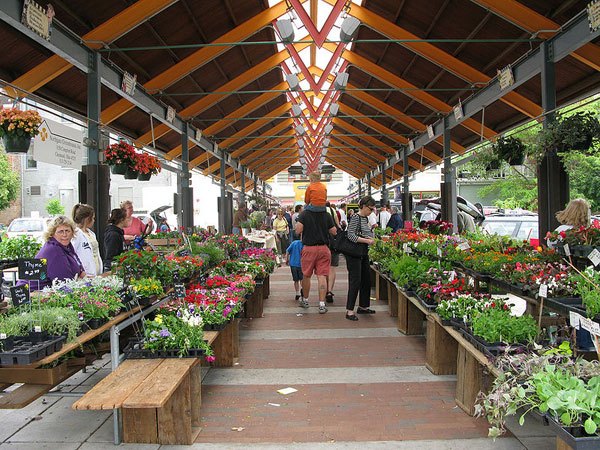 The farmers market at Findlay Market in Over-the-Rhine, Cincinnati, via Wikipedia. This image is licensed under the Creative Commons Attribution-Share Alike 3.0 Unported license.
The farmers market at Findlay Market in Over-the-Rhine, Cincinnati, via Wikipedia. This image is licensed under the Creative Commons Attribution-Share Alike 3.0 Unported license.In the early 20th century, most American cities had large market buildings where farmers trucked in produce and sold it directly to consumers. Today's farmers markets are different, self-conscious antidotes to supermarkets, as well as places for weekend outings. Markets come in different guises: temporary stalls set up in a street or parking lot, permanent outdoor shelters like the one at right, or year-round enclosed buildings. The people behind the stalls may be real farmers or middle-men distributors, and there is often more prepared food than actual produce, but even if the market atmosphere is somewhat contrived, it is cheerful. Interestingly, farmers markets have become so popular that they have influenced how supermarkets sell food, and the fruit and vegetable departments of many chains have done away with chrome-and-glass display cases in favor of casual bins.
-
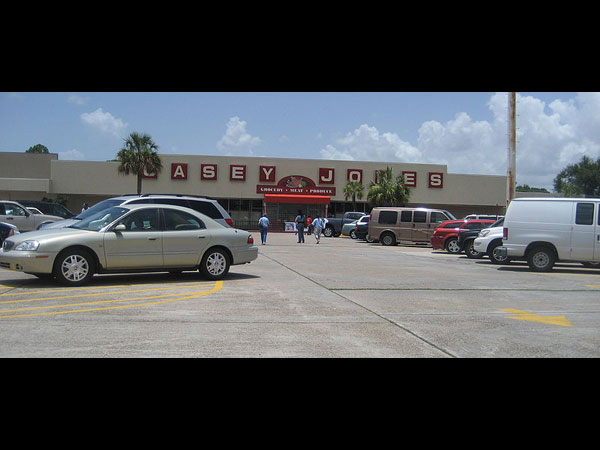 The Casey Jones supermarket in Gretna, La., via Wikipedia. This image is licensed under the GNU Free Documentation License, Version 1.2 or later.
The Casey Jones supermarket in Gretna, La., via Wikipedia. This image is licensed under the GNU Free Documentation License, Version 1.2 or later.Whether you are going to a farmers market or a big-box store, chances are you will have to park. Parking lots, rather than squares and plazas, are the most common public outdoor open spaces in America. They are complicated social spaces, where travelling gives way to arriving, driving to walking, privacy to publicness—and vice versa. Although inevitably described as "seas of asphalt"—they look bleak in photographs—they are orderly, clean places; Jackson once referred to their "austere beauty." Parking lots are also surprisingly civic. People politely observe rules of behaviour for the sake of the common good, parking between the lines, staying out of the handicapped spaces, driving slowly. It is one place where cars and pedestrians happily coexist.
-
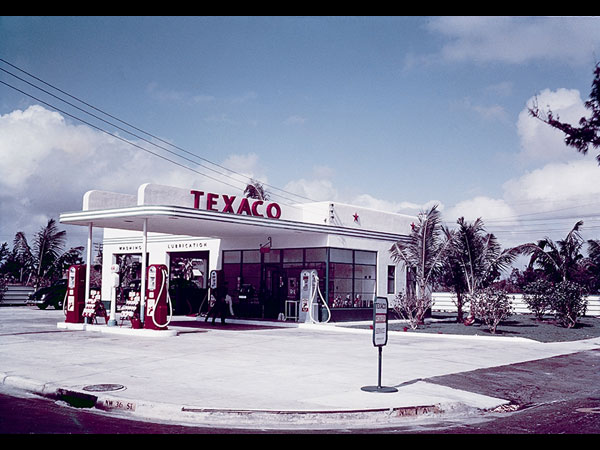 Image courtesy of Walter Dorwin Teague.
Image courtesy of Walter Dorwin Teague.According to J.B. Jackson, vernacular generally suggests something countrified, homemade, or traditional, but some traditions have formal origins. The ubiquitous gas station, for example, owes a large debt to Walter Dorwin Teague, an industrial designer who in the 1930s was responsible for Texaco's streamlined white filling stations as well as its iconic star logo. Roadside garages had been around for a decade or more (the French word dates from the early 1900s), but it was Teague, the designer of the Kodak Brownie camera, who gave them their definitive form. The modern version tends to house a convenience store rather than repair bays, and the uniformed attendants who offered to check your oil and clean your windshield are long gone—perhaps that's why they're not called service stations anymore—but Teague's basic concept of a pump island under a protective canopy has proved remarkably durable.
-
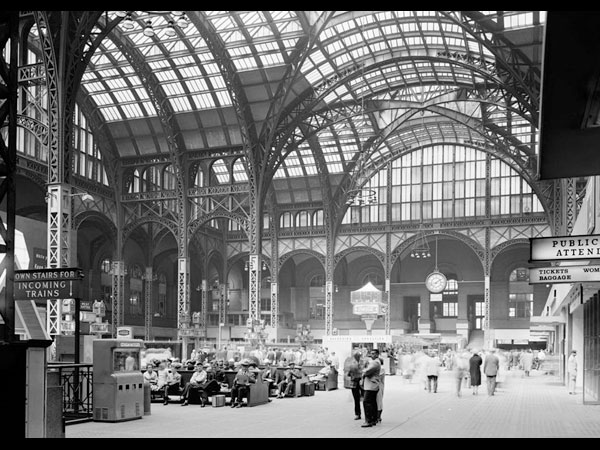 Pennsylvania Station, New York. Photograph by Cervin Robinson, via Wikipedia. This image is in the public domain.
Pennsylvania Station, New York. Photograph by Cervin Robinson, via Wikipedia. This image is in the public domain.The service station name was a nod to a familiar locale: the railroad station. The monumental urban terminals of the first half of the 20th century were a big part of everyday city life. An extraordinary part, if the station was New York's Penn Station (right), which opened in 1910. Architect Charles McKim, who died before the building opened, created a magical iron-and-glass concourse for departing passengers. Such cavernous spaces had no functional justification; they were the result partly of corporate hubris (like grand office building lobbies) and partly of an admirable desire to elevate and inspire. What is impressive about this 1962 photo is the degree to which the (vernacular) everyday world has been kept at bay, or at least controlled—only a few discreet Coca-Cola signs intrude. Although Penn Station was demolished the year after this photograph was taken,* the few surviving railroad station concourses of that era remain as impressive as ever.
Correction, Aug. 23, 2010: This slide originally stated that Penn Station was demolished more than 50 years ago. Its demolition took place in 1963. (Return to the corrected sentence.)
-
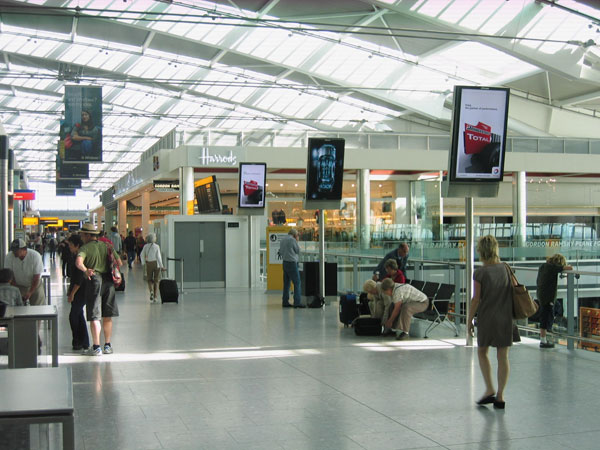 Photograph by Witold Rybczynski.
Photograph by Witold Rybczynski.The closest we've come lately to building inspiring public places in the city, or at least outside the city, are airports. Although most airports still resemble glorified bus stations, a new generation of terminals has revived the idea of the great public room, as in Heathrow's recently opened Terminal 5 in London, designed by Rogers Stirk Harbour + Partners. The entire terminal is housed under one vast, dramatic, monumental glass roof. Like a railroad station concourse, this promotes a sense of community, of taking part in a great collective endeavor—travel. However, while the old railroad station was a rather proper place, aspiring to the image of a first-class hotel, the modern airport really wants to be a shopping mall. Departure lounges are crammed with shops and restaurants, kiosks and billboards, producing an uneasy balance between high-design engineering and vernacular commercialism.
-
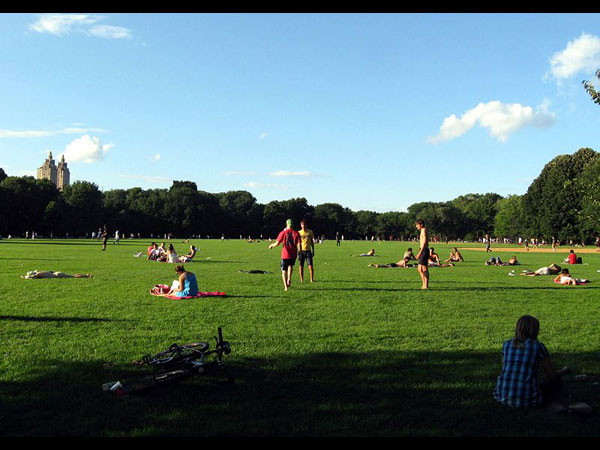 The Great Lawn in Central Park, New York. Photograph by Jim Henderson, via Wikipedia. This image is in the public domain.
The Great Lawn in Central Park, New York. Photograph by Jim Henderson, via Wikipedia. This image is in the public domain.The vernacular landscape, which is capable of invading airports, also transforms places from the past. That is what happened to the 19th-century urban park, which, after a period of severe decline, was rediscovered—and remade. Central Park's Great Lawn (right) was created by Robert Moses in the 1930s specifically to provide a level surface for playing baseball, but parks were originally intended for nothing more strenuous than carriage drives and polite strolls. Sitting on the grass was discouraged if not forbidden. Today's parks are a setting for a bewildering variety of activities, active and passive, solitary and communal, organized and impromptu. Jackson once observed that unlike in the past, when vernacular places included many widely understood signs and symbols—think of the Bethesda Fountain in Central Park, evocative of the post-Civil War Union—modern vernacular places are often spiritually and culturally impoverished. That is, advertising apart, they are almost entirely without symbolic content. That may not be a bad thing. Parks, like parking lots and farmers markets, mean whatever we want them to mean.